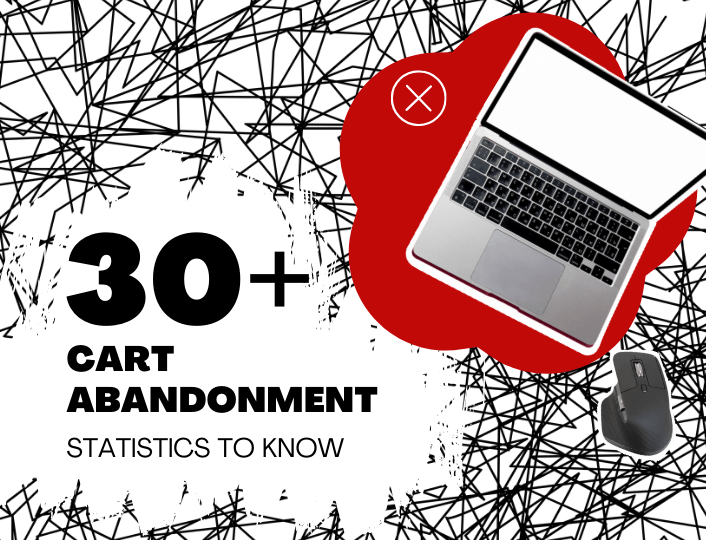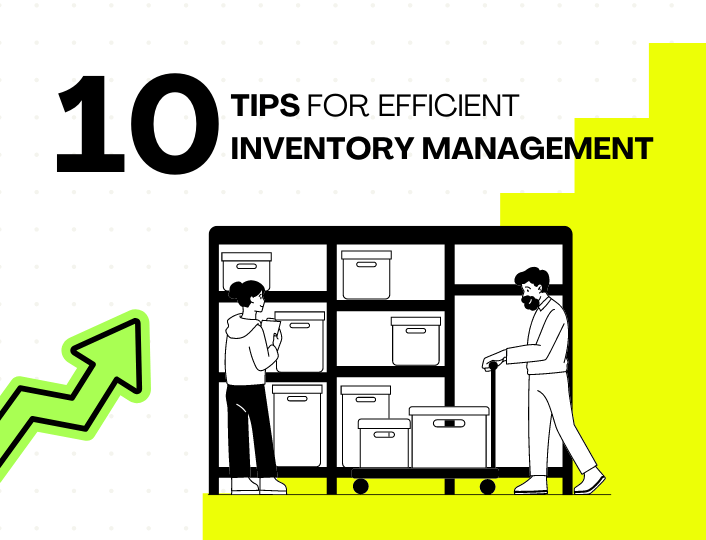Imagine running a grocery store where 7 out of 10 customers walk out without buying anything. That’s the brutal reality of cart abandonment in the e-commerce era.
Cart abandonment happens when customers add products to their online shopping cart but fail to complete the checkout procedure. This occurrence represents a substantial loss for enterprises, resulting in billions of dollars in lost income each year.
Knowing some of these cart abandonment stats is vital for understanding its impact and strategies to mitigate it. In this comprehensive guide, we’ll look into 30+ cart abandonment statistics and how to curb it.
General Cart Abandonment Stats to know
- The average cart abandonment rate across all industries is 69.99%. (Baymard Institute, 2023). This means that for every 100 shoppers who add items to their cart, only 30 will complete the checkout process.
- 65% of shoppers who abandon their carts will return to the retailer’s website within 24 hours. (Barilliance, 2023). This suggests that there is still a chance to regain these lost purchases through retargeting.
- 75% of shoppers who abandon their carts will consider buying from a competitor (Salesforce, 2023). This is why it is crucial to make the checkout process as easy as possible to prevent losing customers to competitors.
- Retargeting emails can help recover up to 26% of abandoned carts. (Invespcro). Retargeting emails can be a very efficient technique to remind shoppers of the things they are interested in and urge them to complete their purchases.
Cart Abandonment Statistics by Device
- The average cart abandonment rate on mobile devices is 85%. (Statista, 2023)
- The average cart abandonment rate on tablets is 81%. (Statista,2023)
- The average cart abandonment rate on desktop devices is 75%. (Statista, 2023)
- 70% of shoppers start shopping on a mobile device, but just 13% complete their purchase on a mobile device. (Shopify, 2023).
You should make sure that their mobile shopping experience is seamless and that it is easy for shoppers to transition between devices if they wish to.
Cart Abandonment Statistics by Industry
- According to SaleCycle, travel and lodging businesses have the highest cart abandonment rate of 87.8%. (SaleCycle, 2020). This is likely related to the fact that travel purchases are generally large and complex, and shoppers are more inclined to evaluate costs and options before making a purchase.
- Fashion and apparel businesses have the second-highest cart abandonment rate of 84.43%. (SaleCycle, 2020) Perhaps because fashion items are generally impulse purchases and shoppers are more inclined to evaluate costs and trends before making a purchase.
- The utility industry has a cart abandonment rate of 75.80%. (SaleCycle, 2020).


Image source: SaleCycle
- Grocery and convenience stores have the lowest cart abandonment rate of 56.6%. (Baymard Institute, 2023). Since we all need groceries, beverages, bread, and other convenience items, we are less likely to abandon our carts because of delivery costs.
- Media and entertainment stores have a cart abandonment rate of 68.4%. (Baymard Institute, 2023). shoppers are likely to rethink and question the quality of the items being purchased from the store.
- Electronics and technology merchants have a cart abandonment rate of 64.3%. (Baymard Institute, 2023). Electronics are a pricey bunch. People generally evaluate pricing against features before making a purchase. Upon evaluation, at least 6 in 10 people bolt from the store, a decision many of us can relate with.
Reasons for Cart Abandonment
- 47% of shoppers abandon their cart because of the high extra cost that could be shipping, tax, or fees. (Baymard Institute, 2023).
- 25% of shoppers abandon their cart because the site wanted them to create an account. (Baymard Institute, 2023).
- 24% of shoppers abandon their cart because the store’s delivery time was too slow for their liking. (Baymard Institute, 2023).
- 19% of shoppers abandoned their cart because they didn’t trust the site to give out their credit card details. (Baymard Institute, 2023).
- 18% of shoppers abandoned their cart because the checkout process was too long or complicated. (Baymard Institute, 2023).
- 17% of shoppers abandoned their cart because they couldn’t see or calculate their total cost upfront. (Baymard Institute, 2023).
- 16% of shoppers abandoned their cart because they were not satisfied with the business return policy. (Baymard Institute, 2023).
- 14% of shoppers abandoned their cart because the website developed an error or crashed. (Baymard Institute, 2023).
- 11% of shoppers abandoned their carts because of limited payment methods. (Baymard Institute, 2023).
- 6% of shoppers abandoned their cart because their card declined. (Baymard Institute, 2023).


Image source: Baymard Institute
- 56% of shoppers abandon their carts because they want to see other retailers’s prices.
- 34% of shoppers abandon their carts because they are not ready to buy.
- 15% of shoppers abandon their carts because they are not satisfied with the product information.
- 14% of shoppers abandon their carts because they are not satisfied with the product reviews.
- 13% of shoppers abandon their carts because they are not happy with the product visuals.
- 12% of shoppers abandon their carts because they are not impressed with the product videos.
- 11% of shoppers abandon their carts because they are not happy with the product pricing.
- 10% of shoppers abandon their carts because they are not satisfied with the product advertising.
(Source: Statista).
Strategies to Reduce Cart Abandonment
Cart abandonment amounts to lost revenue and missed opportunities for e-commerce businesses like yours.
Fortunately, there are some effective strategies you can adopt to minimize your Shopify cart abandonment and enhance your conversion rates.
1. Streamline the Checkout Process
One of the biggest reasons for cart abandonment is the complex and lengthy checkout process. Streamlining the process by limiting the number of steps and form fields can considerably increase the user experience.
Consider implementing a guest checkout option where visitors can complete their purchase without creating an account. This can also make the checkout process easier and faster.
2. Transparent Pricing and Clear Shipping charges
Hidden charges, especially unexpected shipping fees, play a significant part in cart abandonment. Displaying your pricing and delivery costs upfront can help reduce the cart abandonment statistics.
Also, offering free or cheap shipping promotions might inspire customers to proceed with their purchases. This helps set clear expectations for users.
3. Implement Exit-Intent Pop-ups
Exit-intent pop-ups can be excellent tools to attract the attention of consumers who are about to abandon their carts.


Showing tailored offers, discounts, or incentives can urge users to reconsider and complete their purchase. Adoric’s custom exit-intent popups trigger every time a visitor is about to exit your store without completing their checkout.
These pop-ups can be modified to address specific causes for abandonment, such as excessive shipping charges or limited-time incentives.
4. Optimize for Mobile Devices
Given the increasing rate of mobile shopping, it’s vital to optimize your website for mobile devices. Ensure that your website is responsive and that the checkout procedure is seamless on smartphones and tablets.
Mobile-friendly design, clear calls-to-action, and easy navigation can help minimize the risk of cart abandonment.
5. Utilize Abandoned Cart Emails
Email marketing is another effective way to reduce cart abandonment in e-commerce.
Create personalized emails and send them to customers who abandon their carts, reminding them of the items they left behind. Ensure that you send the emails at the right time and consider giving incentives such as discounts or free shipping.
A series of well-crafted follow-up emails can nurture leads and bring hesitant clients back to finalize their purchases.
6. Build Trust with Security Seals
One cart abandonment statistics from the above-listed indicates that poor website security can cause abandonment. Addressing security issues is vital in e-commerce.
Display recognized security seals, such as SSL certificates and trusted payment logos. This informs your customers that you value site security, urging them to stick around.
7. Implement Retargeting Campaigns
According to Invespcro, retargeting can bring back 26% of customers who exited a website without completing an expected task.
Through targeted ads on social media, search engines, or other websites, you can remind potential consumers of the products they left behind and encourage them to checkout.
Personalize the adverts with captivating messaging and visuals that can entice consumers to return to the website and complete their transactions.
Conclusion
You need a holistic approach to reduce cart abandonment. Applying these strategies in your online store creates a more user-friendly and trustworthy purchasing experience, ultimately leading to a decrease in cart abandonment rates and an increase in successful conversions.




